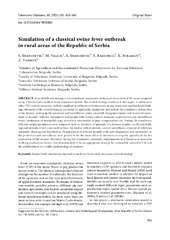Приказ основних података о документу
Simulation of a classical swine fever outbreak in rural areas of the Republic of Serbia
| dc.creator | Stanojević, S. | |
| dc.creator | Valčić, Miroslav | |
| dc.creator | Stanojević, S. | |
| dc.creator | Radojičić, Sonja | |
| dc.creator | Avramov, S. | |
| dc.creator | Tambur, Zoran | |
| dc.date.accessioned | 2020-06-03T14:00:55Z | |
| dc.date.available | 2020-06-03T14:00:55Z | |
| dc.date.issued | 2015 | |
| dc.identifier.issn | 0375-8427 | |
| dc.identifier.uri | https://vet-erinar.vet.bg.ac.rs/handle/123456789/1280 | |
| dc.description.abstract | Several different strategies for control and eradication of classical swine fever (CSF) were compared using a Monte Carlo method-based simulation model. The control strategy analysed in this paper, in addition to other CSF control measures, includes application of biosecurity measures on pig farms and rural backyard holdings. Elements of the control strategy are based on applicable regulations and include the simulation of detection of the disease, setting up the protected and surveillance zones, standstill of pig movements and restricted movement of animals, vehicles, equipment, and people with strong control measures in protection and surveillance zones, euthanasia of susceptible pigs, protective vaccination of pigs, compensation etc. During the simulation, different output parameters were compared such as: duration of epidemic of a disease, number of affected holdings and animals, direct costs such as those for dead or culled animals, costs of surveillance, disposal of infectious materials, cleaning and disinfection. Depopulation of affected animals with early diagnostics and vaccination in the protection and surveillance zone proved to be the most effective measures to stop the spread and for the eradication of the disease. Moreover, during the simulation, systematic implementation of biosecurity measures in all pig production clusters was demonstrated to be an appropriate strategy for sustainable control of CSF and the establishment of a stable epidemiological situation. | en |
| dc.publisher | Czech Academy Agricultural Sciences, Prague | |
| dc.relation | info:eu-repo/grantAgreement/MESTD/Technological Development (TD or TR)/31088/RS// | |
| dc.relation | info:eu-repo/grantAgreement/MESTD/Technological Development (TD or TR)/37015/RS// | |
| dc.rights | openAccess | |
| dc.source | Veterinarni Medicina | |
| dc.subject | Monte Carlo simulation | en |
| dc.subject | classical swine fever | en |
| dc.subject | biosecurity measures | en |
| dc.subject | control strategy | en |
| dc.title | Simulation of a classical swine fever outbreak in rural areas of the Republic of Serbia | en |
| dc.type | article | |
| dc.rights.license | Publisher's own license | |
| dcterms.abstract | Валчић, Мирослав; Станојевић, С.; Радојичић, Соња; Тамбур, Зоран; Aврамов, С.; Станојевић, С.; | |
| dc.citation.volume | 60 | |
| dc.citation.issue | 10 | |
| dc.citation.other | 60(10) | |
| dc.citation.rank | M23 | |
| dc.identifier.wos | 000363178900004 | |
| dc.identifier.doi | 10.17221/8494-VETMED | |
| dc.identifier.scopus | 2-s2.0-84946215029 | |
| dc.identifier.fulltext | https://vet-erinar.vet.bg.ac.rs/bitstream/id/252/1279.pdf | |
| dc.type.version | publishedVersion |

